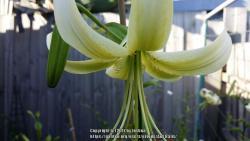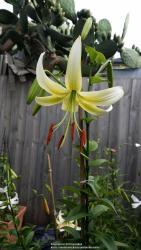I am not too sure how many folks on this forum are interested in hybridizing lilies, but for those that are interested I think it would be valuable to share our hybridizing goals. I appreciate the insight of others, what they are working towards, and how they plan to get there.
Why have hybridizing goals?
Ok, I have to come clean – I am extremely biased on this topic. My personality and training in my profession compound to give me very strong opinions on this topic. For me the answer is crystal clear and I recognize there is more than one way to approach hybridizing. While you don’t have to have hybridizing goals, it does enable you to be more efficient with your resources.
I think of hybridizing like going on a trip. If I am planning to go on a trip it is important to know what the destination is. If I want to go visit my neighbors this doesn’t take much planning but if my destination is further away, then some planning will help to ensure I get there safely in the timeframe I intended for the cost I can afford. Not everyone wants to get to the same destination and some people just like the experience of traveling regardless of the destination. The same goes for hybridizing – there are different interest levels and objectives.
You may be interested in hybridizing because you are just curious about the process and don’t really have an end goal in mind and just want to see what happens when you cross one thing with another. You may be new to hybridizing and are just getting your feet wet or you just enjoy the process of growing, pollinating, harvesting seed, and growing new seedlings. You may be interested in hybridizing because you have a specific area of interest where you want to focus on a particular breeding group and at least in your mind have an idea of where you are interested in going. It may be working on certain flower color, or flower shape/pose, or a cross that has not been done before, or even trying to improve fertility to get more seedlings from a certain breeding group. You may want to try to recreate something you’ve seen or read about or try to come up with something new. Regardless of your interest you would likely benefit from taking a step back and thinking about your destination.
There is nothing wrong with wandering through the garden and just randomly grabbing pollen from one lily and placing it on another. I have done it – still expect I will do it some in the future. There is nothing wrong with letting nature do the pollination – I usually see this referred to as Open Pollination and abbreviated OP for seed in seed exchanges (HP means hand pollinated). There is certainly the possibility that something interesting will come from those seeds. I am not trying to discourage creative pollinating in the garden – just would like to point to some things that may help you be more effective.
Starting with the end in mind allows you to map out a path or strategy. Some questions that this will likely lead to are:
1) Has someone already hybridized a similar plant?
---a. There are many resources to investigate this
--i. Lilium registry has many cultivars listed with a detailed explanation
--ii. Lilium publication like those from NALS, RHS Lily Group, & others have many articles with information from professional to amateur hybridizers and their work
--iii. Catalogues – be cautious of what you read in catalogues as they are trying to sell you something, but there can also be some valuable information
--iv. Ask on the forum


---b. What type of plants did they use to achieve the plant you are interested in?
---c. Are you already growing the plants needed or do you need to find a source?
---d. Are the plants needed commercially available or do you need to raise them from seed?
---e. Does it matter which plant is the pollen parent or the pod parent?
--i. You can often find someone growing one of the plants you are interested in and could ask if they would be willing to send you some pollen.
2) If no one has made a similar plant – are there concepts that can be applied to help you succeed?
3) Do the plants you intend to cross have the same flowering time?
---a. Do you need to force a plant to bloom at a different time?
---b. Do you need to collect, dry, & store pollen?
Let me give you an example – say I wanted to make my own Oriental hybrid by crossing L. auratum & L. speciosum. Many of the hybrids available commercially are very refined but they were also bred for the cut flower industry and as such have blooms that face upward and I don’t care for this for growing in the garden. Early hybridizers learned that it is very difficult to pollinate L. speciosum with L. auratum as often L. speciosum will make apomictic seed and if you make seed, often chemical inhibitors will kill the embryo either before or shortly after germination. They also found that if you do the reverse cross by pollinating L. auratum with L. speciosum, it makes a fair amount of good seed that germinates more normally. The next challenge is that L. auratum generally blooms prior to L. speciosum and depending on the cultivars and your growing area there may be no overlap of bloom time. This means you need to save L. speciosum pollen to use the following year on L. auratum or try to figure out how to force L. speciosum to bloom earlier. These are both viable options but do require some planning.
All right – enough of my rant on the value of hybridizing goals. I will post some of my goals on this thread in a separate post.

Just kidding.
Just kidding.




Just kidding.
)